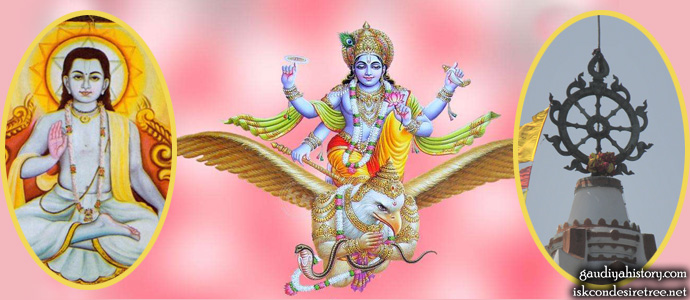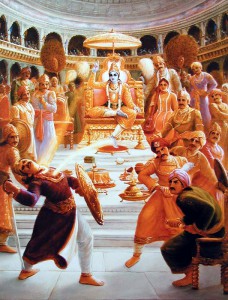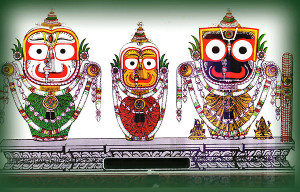Early Life: Shri Nimbarkacharya, believed to be the incarnation of the Sudarshana Chakra, the divine discus weapon of Lord Krishna, was born in the month of Kartika on the full moon evening in 3096 BCE, according to the Bhavishya Purana. His parents, Jayanti and Aruna, were Tailanga Brahmanas residing near the Godavari River at a place known as Telinga, modern-day Vaidurya Pattanam in Andhra Pradesh. He was named Niyamananda at birth.
Scholarship and Quest for a Guru: By the age of 16, Niyamananda had mastered the Vedas and other philosophical scriptures. With his parents’ permission, he embarked on a journey to find a true Guru. His search led him to Govardhan in Mathura, Uttar Pradesh, where he practiced penance under the shade of Neem trees. It was here, in Nimba Grama, that Brahma Ji visited him, recognizing him as the incarnation of the Sudarshan Chakra and bestowing upon him the name Nimbarka.
Initiation and Teachings: During his penance, Nimbarka survived on a mouthful of bitter neem juice once a day. His determination impressed Shri Narada Muni, who initiated him into the Hamsa Sampradaya of Vaishnava Dharma and gave him the Shalagrama Deity known as Shri Sarveshvara. Narada Muni renamed him Haripriya (one dear to the Lord) and blessed him with the knowledge of true Vedanta, the doctrine of Dvaitadvaita (simultaneous oneness and duality).
Vision of Radha-Krishna: Narada Muni instructed Nimbarka to meditate on the Gopala Mantra from the Gopalatapini Upanishad. During his meditation, Lord Shri Radha-Krishna revealed themselves to Nimbarka, reminding him of his eternal position as a Nitya-Mukta Vaisnava and his past glory as the Sudarshana Chakra. They instructed him to teach the philosophy of Dvaitadvaita to all.
Philosophy of Dvaitadvaita: Dvaitadvaita, or simultaneous oneness and duality, is the core teaching of Nimbarka’s philosophy. This doctrine emphasizes that while the soul and God are distinct, they are also inseparably united. This philosophy provides a balanced view that neither purely monistic nor purely dualistic doctrines could offer.
Works and Contributions: On the direction of Narada Muni, Nimbarka composed treatises on the Upanishads, Bhagavad Gita, and the Brahma Sutras. He also practiced daily recitation of the Gopala Mantra and worship of Shri Sarveshwar Bhagavan, which led to the Supreme Vision of Shri Shri Radha Madhava.
Moral and Teachings: Nimbarka’s life and teachings remind us of the importance of humility, devotion, and the recognition of the divine presence in all aspects of life. His doctrine of Dvaitadvaita encourages us to appreciate the simultaneous oneness and duality in our relationship with the Supreme.
Prayer: “O Lord Krishna, please bless us with the vision to see the beauty and purpose in all of Your creations. Grant us humility, compassion, and the ability to respect and serve others selflessly. Help us to overcome our pride and to seek unity and harmony in our relationships.”



